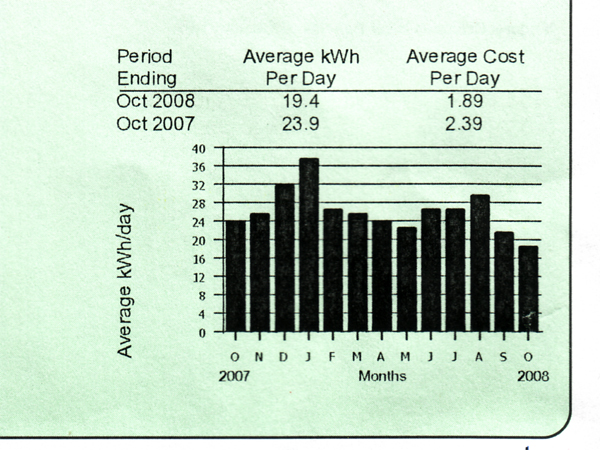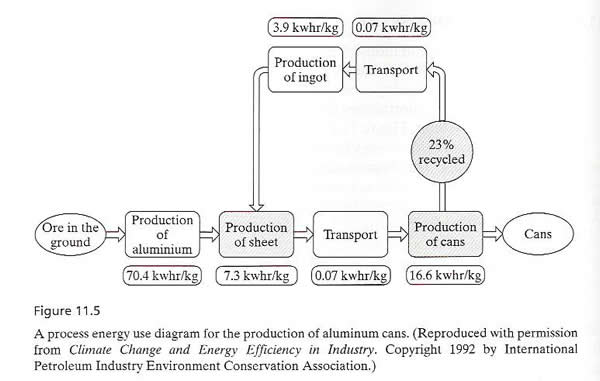WEEK 4 |
| |
1. Lecture slides and notes:
Main themes for today
- energy efficiency
- accounting for all aspects including "embedded" energy
- rebound effect
- genuine progress
A. Energy efficiency
define energy and power
- energy is the ability to do work (force over a distance)
- power is the energy used per unit time
- conversions
energy transformation results in work + heat
- each step looses some energy
- example:
- use 110v wall socket to charge a battery
- use a battery + an inverter to run an appliance
negawatt
- Amory Lovins
- investing in saving a watt is cheaper than creating facilities to create an additional watt
Energy equivalents:
1 gal of gas = 6.3 pounds --> 19 lbs of CO2
1 gal of gas = 31 kwhr of energy
20 to 40 kwhr per day at $0.10 per kwhr --> $2 to $4 day of electricity

Rebound effect -
Savings obtained through more efficiency will be eclipsed by increased use.
|
B. Energy accounting
The questions are:
1) Is it better to build expensive stuff that requires less energy to run or use cheaper stuff?
- higher embedded and lower operation energy
- lower embedded and higher operation energy
2) How do we account for these different types of energy and make decisions based on that information?
4 examples:
- home energy
- aluminum recycling
- foot-print of a car
- life-cycle analysis of cars
1. Home energy
How much energy is saved when we build an energy efficient house?
How much energy is in all the materials in a house?
link
energy efficient vs. standard home
cold climate
What can we do in warm climates? Roofing designed to radiate heat.
2. aluminum recycling

Energy savings of:
for each can recycled
0.07 + 3.9 +7.3 + 0.07 + 16.6 = 27.94
70.4 + 7.3 + 0.07 + 16.6 = 94.37 kwhr/kg of aluminum
28/94 = only 30% as much energy per can
some estimates say that it's only 5% of the energy for a recycled can
even assuming 5 kwhr/kg of cans:
75 cans per kg
67 watt*hr per can
like leaving a 100 watt bulb on for 40 minutes
unrecycled can would be 1300 watt*hr/can
20 of those unrecyled cans would be equivalent to a gallon of gas in energy
Discuss -
3. carbon footprint of a car
Carbon footprint is the amount of average arable land it would take to consume the carbon emitted by the particular activity.
example - ecological footprint of using a car
4. lifecycle analysis
full accounting of costs from construction, through use, and to recycling or disposal
simple example:
- energy used to construct an automobile (about 10 to 15%)
- energy used during the life of the vehicle
(about 75 to 85%)
- energy used to deconstruct and dispose of the vehicle (about 5 to 10 %)
controversy "Prius vs. Hummer - dust to dust"
claims by the CNW Marketing:
- Prius is more expensive to operate ($2.87/mile) (mostly from gas costs) over its lifetime than a Hummer ($2.07).
- Nickle used in the Prius is causing destruction of the forests in Canada.
- Recycling and disposal costs for the battery in the Prius would be very high.
these ideas were picked up by the media and may have "disorted the public debate" (according to the Pacific Institute).
response for other institutions that study such issues
- the claims are very sensitive to the assumptions
- CNW didn't publish assumptions or have any peer review that might have helped catch these
- for example used 109k miles for Prius and 379k miles for the Hummer H1, and 12 year lifetime for the Prius and 35 years for the Hummer.
- CNW assumed that the majority of the energy is associated with the production of the vehicle whereas all other studies show it's around 10%
links:
|
C. Switching to renewable
need to take the same steps in analysis
(maybe not in this order)
What are the short-term/immediate energy efficiency gains?
- using the energy near where it was created
- generating the energy as it's needed
- avoiding transmission losses
Is this really a product or service that is worthwhile?
What is the global impact
- carbon emissions in excess of consumption is a global impact
- carbon footprint gets at this
- other forms of pollution (Hg, N into oceans, etc)
What's a better way to assess the overall impact?
- Life Cycle Analysis (LCA)
- consumption of energy, water, and land
How would we set up a system to reach these goals?
|
| |
2. In-class assessment:
week 4 in-class assessment, results and comments
|
3. Reading in the text - "Multiple Perspectives and Approaches to Complex Environmental Problems"
Chapter 10: Environmental Accounting
|
4. Readings from Wikipedia and Encyclopedia of Earth:
EofE - Carbon footprint
EofE - Renewable energy
wiki - negawatt
EofE - rebound effect
wiki - genuine progress indicator
|
5. On-line activities:
Video:
Happy Planet Index
http://www.ted.com/talks/nic_marks_the_happy_planet_index.html
using indices to promote social change
http://www.happyplanetindex.org/learn/video.html
compare indicies:
Look for what goes into these indicies and how they are different.
Well-being index
Genuine Progress Indicator - for Maryland <-- good treatment on the difference
GPI vs. Gross National Product
Chittenden County, Vermont
Toward and ecological economy
Happiness Index
Simulations:
run the comparisons of green jobs, smart growth and ???? in the Maryland GPI models
|
6. Learning objectives:
week 4 learning objectives
|
7. Link to the on-line assignment:
Week 4 Assessment is due by Monday night at 11:59 PM
|
| |


![]()